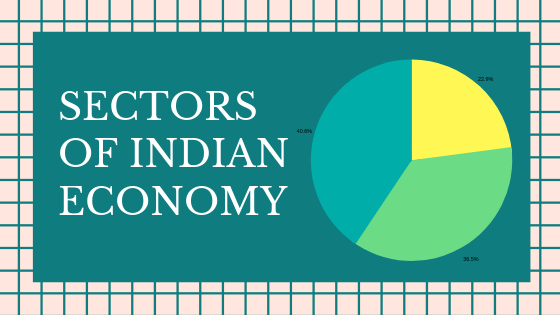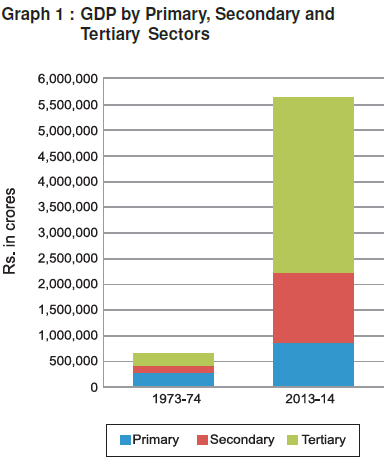
Sectors of Economic Activities
Sector defines a large segment of the economy in which businesses share the same or a related product or service.
- When we produce a good by extraction and collection of natural resources, it is known as the primary sector. Eg: Farming, forestry, hunting, fishing and mining.
- The secondary sector covers activities in which natural products are changed into other forms through ways of manufacturing. It is the next step after primary. Some manufacturing processes are required here. It is also called the industrial sector. For example, using cotton fibre from the plant, we spin yarn and weave cloth. Using sugarcane as raw material, we make sugar or gur.
- Tertiary sector includes activities that help in the development of the primary and secondary sectors. These activities, by themselves, do not produce a good but they are an aid or support for the production process. It is also called the service sector. Example: Teachers, doctors, washermen, barbers, cobblers, lawyers, call centres, software companies, etc.
Comparing the 3 Sectors
The value of final goods and services produced in each sector during a particular year provides the total production of the sector for that year. The sum of production in the three sectors gives Gross Domestic Product (GDP) of a country. GDP is the value of all final goods and services produced within a country during a particular year. It shows how big the economy is. In India, the task of measuring GDP is undertaken by a central government ministry.
The graph below shows the production of goods and services in the three sectors.

In the year 2013-14, the tertiary sector emerged as the largest producing sector in India, replacing the primary sector. The tertiary sector has become important in India because of the following reasons:
- Services such as hospitals, educational institutions, post and telegraph services, police stations, courts, village administrative offices, municipal corporations, defence, transport, banks, insurance companies, etc. are considered as basic services and are necessary for all people.
- The development of agriculture and industry leads to the development of services such as transport, trade, storage, etc.
- With the rise in the income of people, they start demanding more services like eating out, tourism, shopping, private hospitals, private schools, professional training, etc.
- Over the past decade, certain new services based on information and communication technology have become important and essential.
Where are Most People Employed
| Primary Sector | Secondary Sector | Tertiary Sector |
| More than half of the workers in India are working in the primary sector, mainly in agriculture. | These sectors employ less than half the people as compared to the primary sector. | |
| It contributes to only a quarter of the GDP. | These sectors produce four-fifths of the product. | |
How to Create More Employment
Employment can be given to people by identifying, promoting and locating industries and services in semi-rural areas. Every state or region has the potential for increasing the income and employment for people in that area. It can be done by tourism, or regional craft industry, or new services like IT. A study conducted by the Planning Commission (known as NITI Aayog) estimates that nearly 20 lakh jobs can be created in the education sector alone.
The central government in India made a law implementing the Right to Work in about 625 districts of India, which is called Mahatma
Gandhi National Rural Employment Guarantee Act (MGNREGA) 2005. Under MGNREGA 2005, all those who are able to, and are in need of work in rural areas are guaranteed 100 days of employment in a year by the government. If the government fails in its duty to provide employment, it will give unemployment allowances to the people.
Division of Sectors As Organised and Unorganised
| Organised Sector | Unorganised Sector |
| It is a sector where the employment terms are fixed and regular, and the employees get assured work. | The unorganised sector is characterised by small and scattered units, which are largely outside the control of the government. |
| They are registered by the government and have to follow its rules and regulations, which are given in various laws such as the Factories Act, Minimum Wages Act, Payment of Gratuity Act, Shops and Establishments Act, etc. | There are rules and regulations but these are not followed since they are not registered with the government. |
| The job is regular and has fixed working hours. If people work more, they get paid for the overtime by the employer. | Jobs are low-paid and often not regular. |
| Workers enjoy the security of employment. | Employment is not secure. People can be asked to leave without any reason. |
| People working in the organised sector get several other benefits from the employers such as paid leave, payment during holidays, provident fund, gratuity, etc. | There is no provision for overtime, paid leave, holidays, leave due to sickness, etc. |
| People get medical benefits. The factory manager has to ensure facilities like drinking water and a safe working environment. When they retire, these workers get pensions as well. | There are no such facilities in the unorganised sector. |
| Examples of the organised sectors are Government employees, registered industrial workers, Anganwadi workers, village health workers, etc. | Examples of the unorganised sectors are Shopkeeping, Farming, Domestic works, Labouring, Rickshaw pulling, etc. |
How to Protect Workers in Unorganised Sector
There is a need for protection and support of the workers in the unorganised sector. Here are a few points which will help in doing so.
- The government can fix the minimum wages rate and working hours.
- The government can provide cheap loans to self-employed people.
- Government can provide cheap and affordable basic services like education, health, food to these workers.
- The government can frame new laws which can provide provision for overtime, paid leave, leave due to sickness, etc.
Sectors in Term of Ownership: Public and Private Sectors
| Public Sector | Private Sector |
| In the public sector, the government owns most of the assets and provides all the services. | In the private sector, ownership of assets and delivery of services is in the hands of private individuals or companies. |
| Railways or post office is an example of the public sector. | Companies like Tata Iron and Steel Company Limited (TISCO) or Reliance Industries Limited (RIL) are privately owned companies. |
| The purpose of the public sector is not just to earn profits. Its main aim is public welfare. | Activities in the private sector are guided by the motive to earn profits. |
Responsibilities of Government
There are a large number of activities which are the primary responsibility of the government. Here, we have listed a few of them:
- Government raises money through taxes and other ways to meet expenses on the services rendered by it.
- Governments have to undertake heavy spending such as the construction of roads, bridges, railways, harbours, generating electricity, providing irrigation through dams, etc. Also, it has to ensure that these facilities are available for everyone.
- There are some activities, which the government has to support to encourage the private sector to continue their production or business.
- The government in India buys wheat and rice from farmers at a ‘fair price’ and sells at a lower price to consumers through ration shops. In this way, it supports both farmers and consumers.
- Running proper schools and providing quality education, health and education facilities for all are some of the duties of the government.
- Government also needs to pay attention to aspects of human development such as availability of safe drinking water, housing facilities for the poor and food and nutrition, taking care of the poorest and most ignored regions of the country.
Comments
Post a Comment